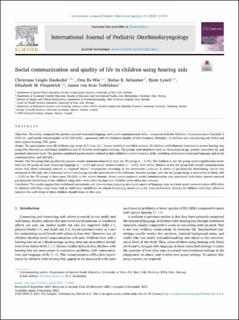| dc.contributor.author | Haukedal, Christiane Lingås | |
| dc.contributor.author | Wie, Ona Bø | |
| dc.contributor.author | Schauber, Stefan | |
| dc.contributor.author | Lyxell, Björn | |
| dc.contributor.author | Fitzpatrick, Elizabeth | |
| dc.contributor.author | Torkildsen, Janne von Koss | |
| dc.date.accessioned | 2022-08-25T11:14:36Z | |
| dc.date.available | 2022-08-25T11:14:36Z | |
| dc.date.created | 2021-12-06T20:22:45Z | |
| dc.date.issued | 2022-12-06 | |
| dc.identifier.citation | International Journal of Pediatric Otorhinolaryngology. 2022, 152 1-11. | en_US |
| dc.identifier.issn | 0165-5876 | |
| dc.identifier.uri | https://hdl.handle.net/11250/3013530 | |
| dc.description.abstract | Objectives: This study compared the parent-reported structural language and social communication skills—measured with the Children’s Communication Checklist-2 (CCC-2)—and health-related quality of life (HR-QOL)—measured with the Pediatric Quality of Life Inventory (PedsQL)—of children who use hearing aids (HAs) and their typical-hearing (TH) peers.
Design: The participants were 88 children (age range of 5; 6 to 13; 1 (years; months)) and their parents: 45 children with bilateral moderate to severe hearing loss using HAs who had no additional disabilities and 43 children with typical hearing. The groups were matched based on chronological age, gender, nonverbal IQ, and parental education level. The parents completed questionnaires related to their children’s communication skills, including subdomains structural language and social communication, and HR-QOL.
Results: The HA group had significantly poorer overall communication skills than the TH group (r = 0.49). The children in the HA group scored significantly lower than the TH group on both structural language (r = 0.37) and social communication (r = 0.41). Half of the children in the HA group had overall communication scores that either indicated concern or required further investigation according to the instrument’s manual. In terms of psychosocial functioning, which was measured as HR-QOL, the subdomain school functioning was the main driver of the difference between groups, with the HA group being at least twice as likely (OR = 2.52) as the TH group to have poor HR-QOL in the school domain. Better parent-reported social communication was associated with better parent-reported psychosocial functioning in the children using HAs—even when background variables were taken into account.
Conclusion: The results suggest that traditional assessments and interventions targeting structural aspects of language may overlook social communication difficulties in children with HAs, even those with no additional disabilities. As school functioning stood out as the most problematic domain for children with HAs, efforts to improve the well-being of these children should focus on this area. | en_US |
| dc.description.sponsorship | This research was funded by the Norwegian Directorate of Health, Oslo University Hospital and University of Oslo. | en_US |
| dc.language.iso | eng | en_US |
| dc.publisher | Elsevier | en_US |
| dc.relation.ispartofseries | International Journal of Pediatric Otorhinolaryngology;Volume 152, January 2022, 111000 | |
| dc.relation.uri | https://www.sciencedirect.com/science/article/pii/S0165587621003931 | |
| dc.rights | Navngivelse 4.0 Internasjonal | * |
| dc.rights.uri | http://creativecommons.org/licenses/by/4.0/deed.no | * |
| dc.subject | Hearing-impaired children | en_US |
| dc.subject | Hearing aids | en_US |
| dc.subject | Social communication skills | en_US |
| dc.subject | Structural language | en_US |
| dc.subject | Quality of life | en_US |
| dc.title | Social communication and quality of life in children using hearing aids | en_US |
| dc.type | Peer reviewed | en_US |
| dc.type | Journal article | en_US |
| dc.description.version | publishedVersion | en_US |
| dc.rights.holder | © 2021 The Authors | en_US |
| dc.source.articlenumber | 111000 | en_US |
| cristin.ispublished | true | |
| cristin.fulltext | original | |
| cristin.qualitycode | 1 | |
| dc.identifier.doi | https://doi.org/10.1016/j.ijporl.2021.111000 | |
| dc.identifier.cristin | 1965315 | |
| dc.source.journal | International Journal of Pediatric Otorhinolaryngology | en_US |
| dc.source.volume | 152 | en_US |
| dc.source.issue | 152 | en_US |
| dc.source.pagenumber | 1-11 | en_US |

